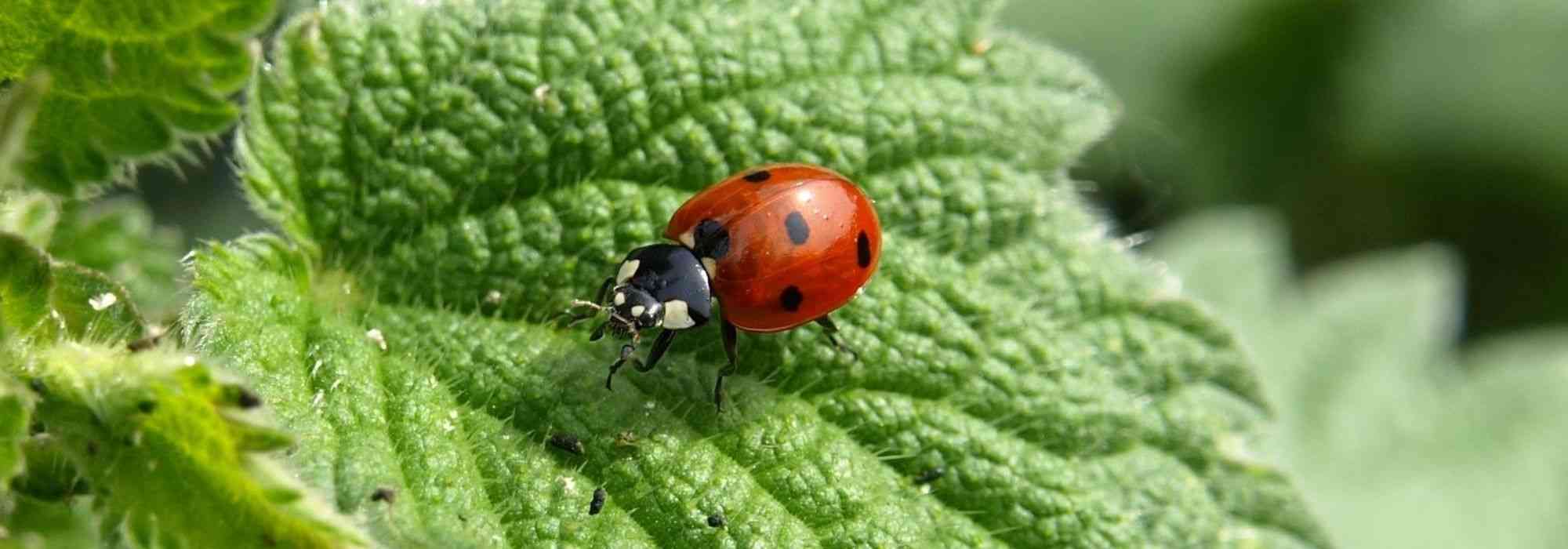
Welcoming garden insects: 7 shelters to build yourself
To help beneficials in the garden
Contents
Insects are disappearing and many gardeners are concerned. Fortunately, we can do something in our gardens by creating numerous shelters or homes for garden insects and by promoting biodiversity in our little corners of paradise.
More good news: it’s fairly easy to make small shelters or homes for certain insects, requiring neither specialist skills nor costly materials. It is also advisable to choose natural, healthy materials sourced from our immediate environment to build these shelters. We’ll tell you everything in this advice sheet!
Why help insects?
They’re in a sorry state… not our fault! In just 30 years, three quarters of insect populations have disappeared amid near-universal indifference. Causes of insect decline, or arthropod decline more broadly, are multiple: climate change, long-term use of insecticidal products, loss of natural habitats, intensive agriculture, arrival of exotic predators or parasitic species…
Yet we need them! Insects take part in pollination of plants, in dispersal of certain seeds (this is called entomochory), in recycling of organic waste, in control of crop pests, and as food for insectivorous animals (themselves also in decline)… Let us not forget that every living being has a definite role in our ecosystems. If one of them disappears, the whole balance collapses!
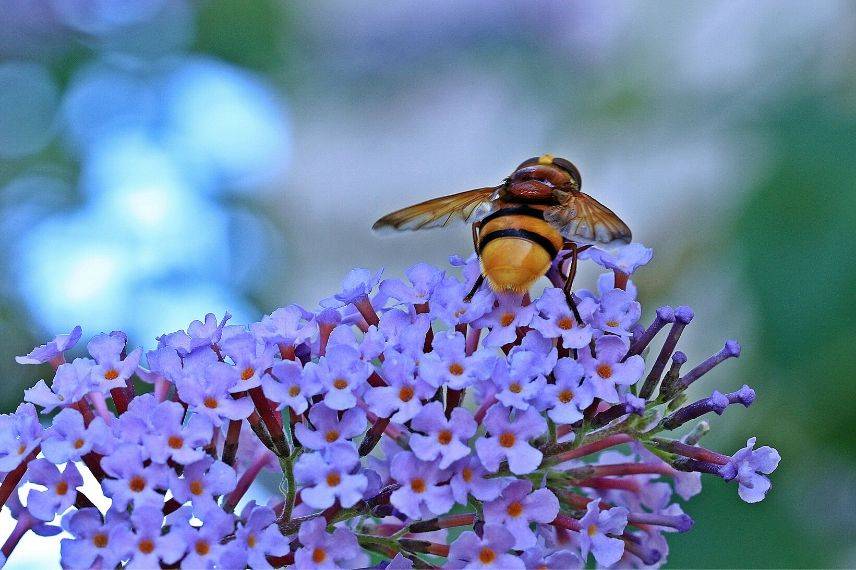
Shelters for solitary bees... and solitary wasps
For which garden insects?
For solitary bees, mason bees and some solitary wasps. In nature, some wood-boring insects carve galleries that are then used by solitary bees for laying eggs. Solitary bees make up more than 80% of wild bees and are extremely useful for pollination. Solitary wasps, meanwhile, lay a larva in the galleries once bee’s back is turned. That larva will feed on bee larvae that have hatched in the gallery.
Warning! If your soil is not clayey, leave some small balls of clay near shelters. Bees need clay to plug galleries.
Materials and equipment to prepare
- hardwood logs such as oak, chestnut or hornbeam but never resinous or white wood (poplar or birch) as they swell with moisture
- drill-driver with various wood bits from 4 to 15 mm diameter
- wooden boards 20 cm x 20 cm
- string or wire
- screws (optional)
Making a shelter for solitary bees and wasps
- use hardwood logs in which holes of different diameters will be drilled for different species of bees. Holes must not go through the log. Simplest is to use log sections about 15 cm in diameter and 10 cm long;
- log can be fixed with screws to a wooden board, itself fitted with string or wire. Whole assembly can then be hung from a tree or wall, or simply place several logs in a wooden box (making sure they are braced) that you can secure;
- if desired, you can also create a “small roof” to fix on top of the log to protect log and its entrance from rain.
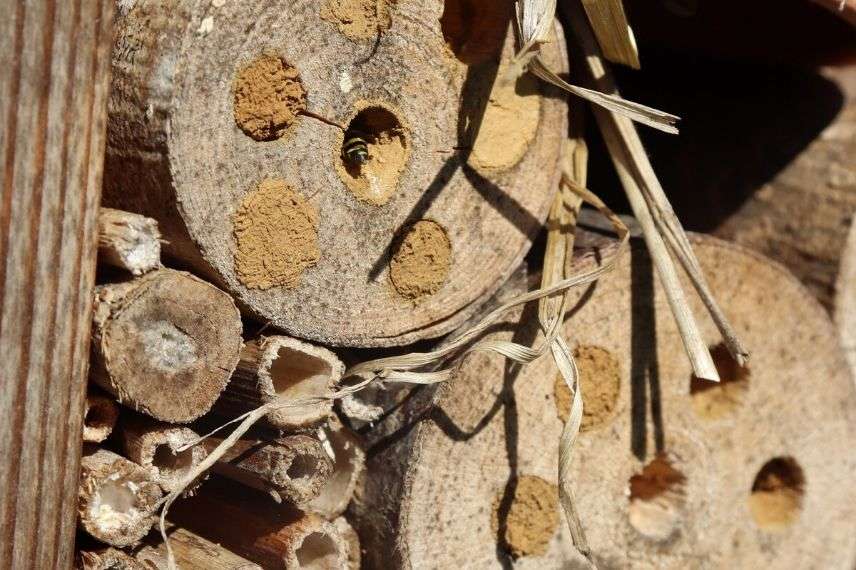
A few drilled logs delight garden insects such as mason bees and small solitary wasps
Where to place these shelters?
Position logs so their hole-facing side faces south or south-east, ideally sheltered from wind and rain.
Terricolous bee shelters: Sandarium
Which garden insects?
Many wild bee and mason bee species nest in soil in very sandy ground. Bees dig galleries, lay eggs there and young bees emerge as soon as sand is warm enough the following year. Sandy patches are rare in gardens, which is why creating a small sandarium is important.
Equipment and materials to prepare
- Spade and shovel.
- Pebbles
- Gravel
- Coarse sand
- A few logs to place around to mark its location
Creating a shelter for terricolous bees
- Excavate soil to a depth of 20 cm for an area of one to two square metres;
- Fill the pit with pebbles, then a layer of gravel and finally a good layer of coarse sand. If the sand is too fine, the galleries will collapse;
- Remember to weed regularly to prevent the sand being covered by vegetation;
- Finally, try to protect your installation from dogs, cats or other neighbours that might trample or foul the sandarium.
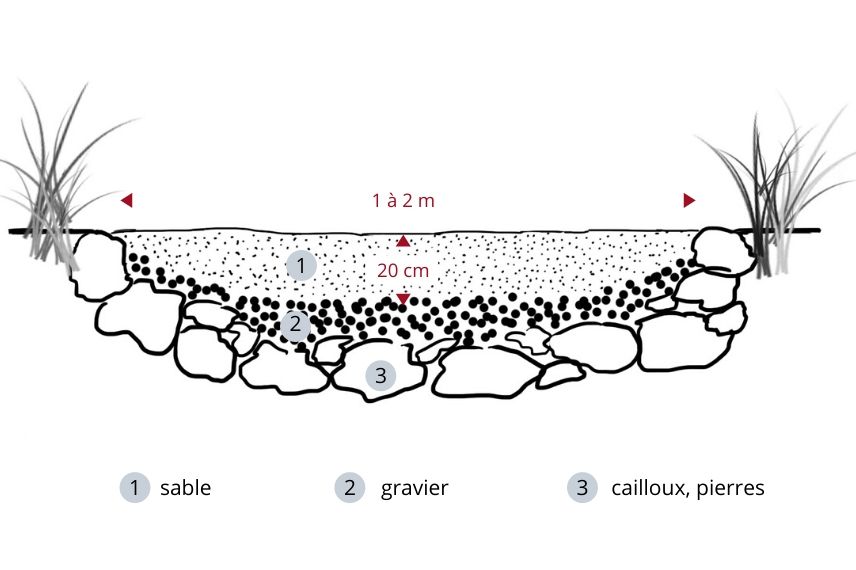
Diagram of a sandarium
Where to place these shelters
Place them in full sun in an open, quiet area of the garden.
Read also
Planting a hedge for insectsShelters for stem-nesting and ground-nesting bees
Which insects?
Bees that nest in pith-filled stems nest in stems containing pith (examples: elder, bramble, rose) and bees that nest in hollow stems nest in hollow stems (examples: bamboo, reed). Some species of wild wasps also like to lay their eggs in pith-filled stems.
Materials and equipment needed
- pruning shear
- tin cans
- string
- branches or hollow stems of different diameters
- branches or pith-filled stems of different diameters
- clay
Making a shelter for hollow-stem and pith-stem bees
- cut several dozen short lengths of hollow or pith-filled stems about ten centimetres long with an internal diameter between 12 mm and 6 mm;
- seal one end with clay;
- bundle the stems with string and place them in tin cans or similar.
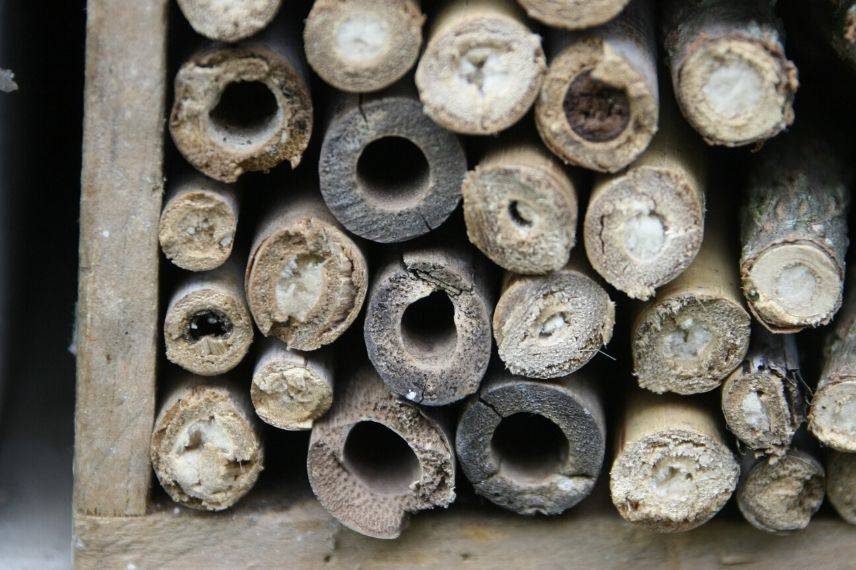
Mixture of pith-filled and hollow stems in a wooden box
Where to place these shelters?
You can put them almost anywhere but sheltered from rain and, if possible, in sunny spots. Some solitary bees prefer vertical stems, others horizontal ones, so vary the orientation.
Earwig shelters
Which insects in the garden?
Earwigs, also called perce-oreilles, are very useful insects in gardens, especially in orchards, because they reduce numbers of aphids and psyllids but they also eat many larvae and even slug eggs.
Materials and tools required
- string
- piece of branch
- filament or flexible wire mesh
- terracotta pot
- straw
Making a shelter for earwigs
- Attach a string to a small 3-centimetre piece of branch;
- Pass the lot through the hole in the terracotta pot so that when you hold the string the pot is upside down;
- Fill this pot with straw or dry herb;
- You can fasten a piece of chicken wire or wrap everything in a filament so that the straw stays in the pot.

Earwig shelter
Where to place these shelters?
Install them in fruit trees or ornamental trees if you suspect aphids or psyllids. Attach to branch or wedge in a hollow between two branches.
Lacewing shelters
Which garden insects?
Lacewings feed on aphids, mites and small caterpillars. They normally overwinter in heaps of wood or dead leaves but you can make a small shelter to observe them.
Materials and equipment required
- an old box made of wood that can be closed or, if not available, a cardboard box
- straw
- raffia or string
- a drill and 10 mm wood drill bits
Making a shelter for lacewings
- drill holes in the lid of the box with your drill;
- fill the box with straw then close it;
- take your box, securely closed, and wrap it with raffia or string to keep it shut.
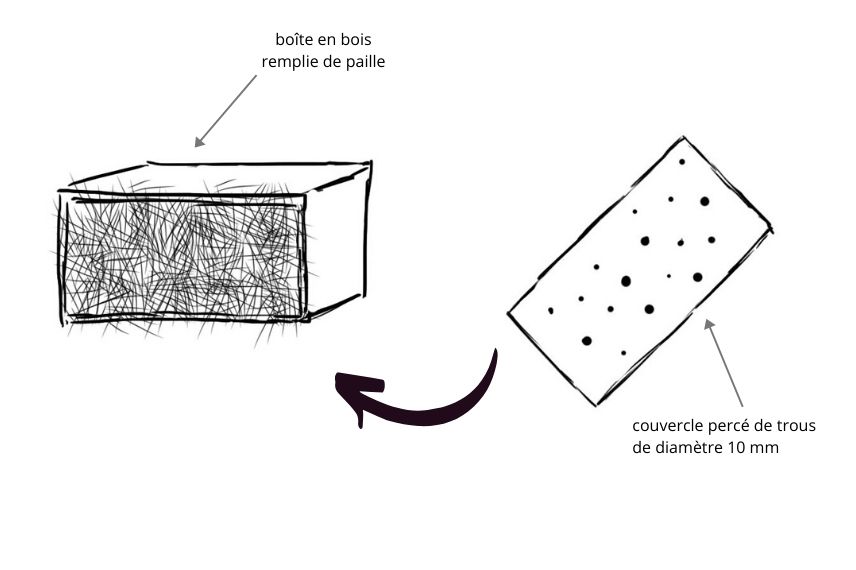
Shelter for lacewings
Where to place these shelters?
Place this shelter in a sunny spot but protected from damp.
Ladybird shelters
Which garden insects?
Ladybirds are well-known helpers for gardeners. They feed on aphids and gather together to overwinter. Note that there are many different native species.
Materials and equipment to prepare
- threaded rod about twenty centimetres long;
- 6 untreated wooden boards, 5 mm thick and about 15 cm square;
- 7 nuts with a hole the same diameter as the threaded rod;
- drill and wood drill bit;
- wooden box open at the front.
Making a ladybird shelter
- drill a hole slightly larger in diameter than the threaded rod at the centre of your boards;
- assemble everything on the threaded rod, alternating nuts and boards like a layered stack;
- place everything in a wooden box open at the front.
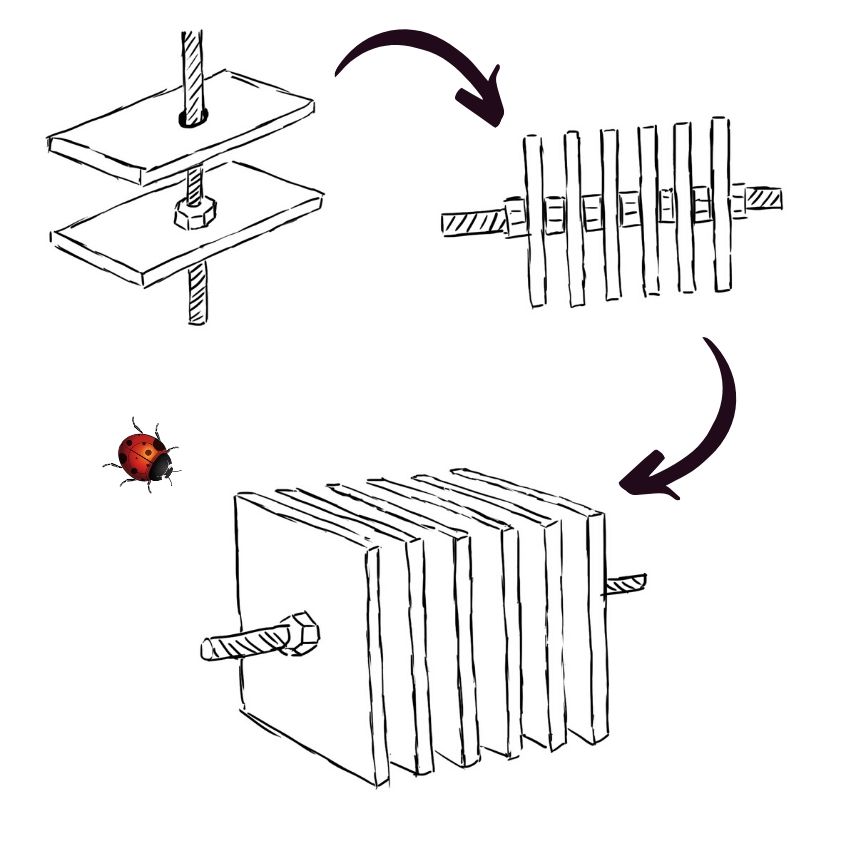
Ladybird shelter
Where to place these shelters?
Hang it on a tree or on a wall facing south or south-east and, if possible, sheltered from rain and wind.
Stone shelters: stone pyramid - spiralled - pile of stones
For which garden animals?
It may seem odd but single piles of stones not mortared together serve as little shelters for wildlife: small mammals, reptiles, amphibians, spiders… You can make them into a pyramid, a spiralled herb garden or simply a loose pile of stones without any particular structure. Butterflies like to bask on stones in the sun. Some arthropods, insects and others like to slip into them to shelter, overwinter or… hunt other insects.
Materials needed
Stones, paving stones, old bricks, slabs, even roof tiles… Anything vaguely mineral.
Building a dry-stone shelter
- place your largest stones on the ground;
- little by little, build the wall or simple pile by adding slightly smaller stones, making sure each is well wedged. Don’t hesitate to try different stones to find the most suitable and to move them so each sits as well as possible. As the wall or pile is not mortared, construct your “structure” so it will not collapse at the slightest visit from a small squirrel.
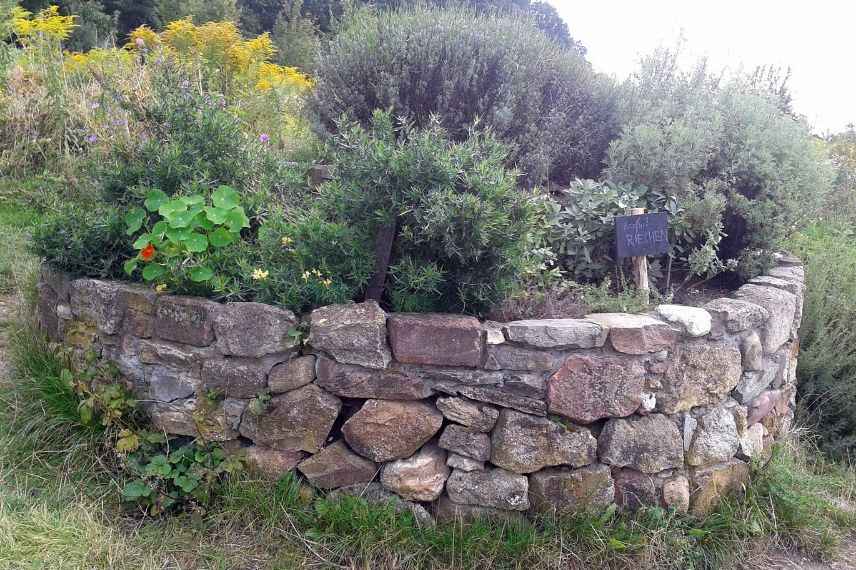
Creating a spiralled herb garden
To create a spiralled herb garden, you can also consult our advice sheet : Create a spiralled herb garden.
Where to place piles of stones?
Place your pile of stones or your spiralled herb garden in a sunny spot.
I bought an insect hotel — is that a good idea?
Yes… and no.
It’s fashionable, after all! People place a large, poorly designed insect hotel in the middle of an empty roundabout or one planted with plants of no ecological interest. Local officials take a nice photo for the local rag. And everyone thinks they’ve saved the planet!
First of all, beware of commercial insect hotels! They are often poorly designed because rarely conceived by entomologists. Moreover, they are not always made from durable, natural and local materials. Sometimes they are even treated… with insecticidal products.
But even when built yourself, it’s not always a good idea! In reality, an insect hotel capable of housing several different types of insects brings together insects that have no business being together: like some sort of council block where young students would be neighbours of serial killers… You see the idea? Add to that a health issue because too many insects are concentrated too close together, which raises the problem of diseases and parasitic organisms that can develop there.
As you will have understood, to help insects, it’s better to make single-species insect shelters, that is insect houses for a single species or a single type of insect.
But that doesn’t mean these insect hotels have no use! They have great educational value. They are therefore very useful in schools or even in your garden to observe and learn more about insects whether you’re a small child or a big kid.
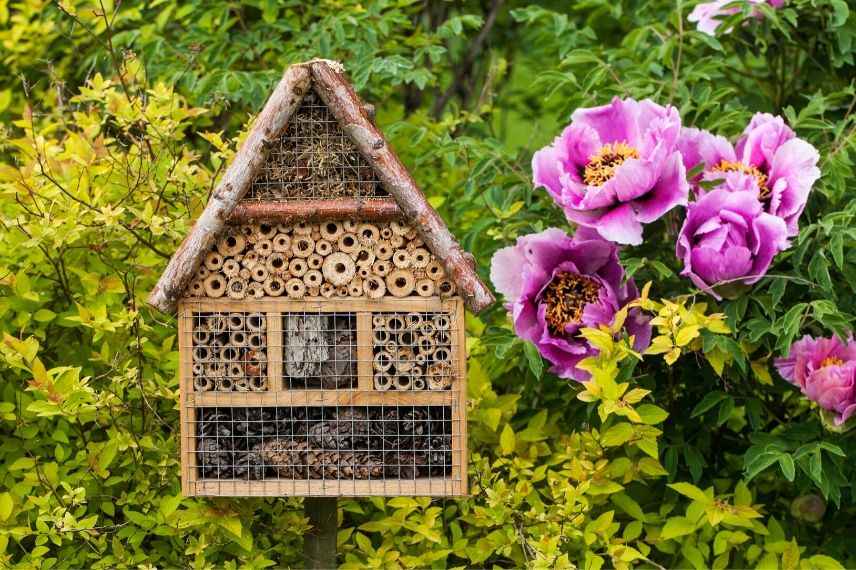
→ By the way, if you want to make an “insect hotel” for your home, read Virginie’s article on this subject: Make an insect hotel: tutorial.
To go further...
Helping useful insects by providing them with small shelters is good; prioritising nature in your garden is better!
And it’s quite easy! Just welcome as many native plants with melliferous and nectariferous flowers as possible. Also remember to plant species that flower early or, conversely, late in the season. Furthermore, most insects have co‑evolved with certain plants and therefore specifically need those plants to feed or to feed their larvae. Butterfly caterpillars are the most striking example.
The compost heap is also a privileged medium for many insects that live there year‑round or that hibernate there while waiting for warmer weather. Surface composting as well as no‑dig soil management are also recommended. Remember to leave dead leaves on the soil: they enrich it and provide an overwintering site for some insects.
Dead wood is shunned in gardens, wrongly so! It provides shelter and food for many xylophagous insects but not only them. So leave a few logs or bundles of branches in secluded spots of the garden. Standing dead wood is also very valuable provided it does not pose a risk of falling.
A natural pond is an ecosystem in its own right, offering a perfect medium for aquatic insects or for those whose larvae need to live in water, such as dragonflies, for example. If you have the space, don’t hesitate to dig one.
Finally, a few areas left fallow, i.e. unmown, will be incredibly rich in wildlife!
Discover also our articles :
- 8 most melliferous climbing plants
- Subscribe!
- Contents
































Comments